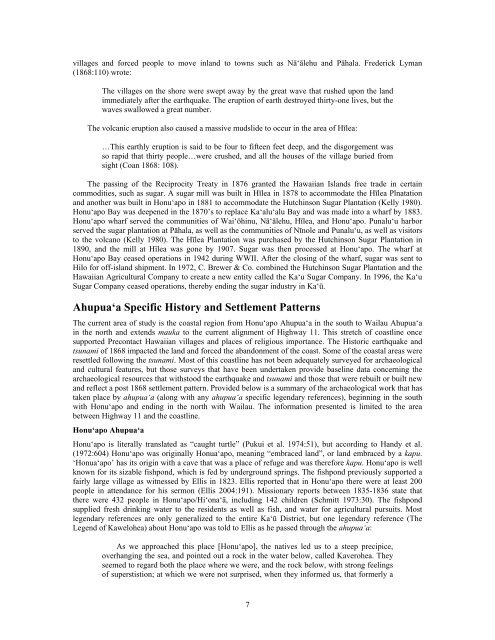Honu'apo Park Resource Management Plan
Honu'apo Park Resource Management Plan
Honu'apo Park Resource Management Plan
You also want an ePaper? Increase the reach of your titles
YUMPU automatically turns print PDFs into web optimized ePapers that Google loves.
villages and forced people to move inland to towns such as Nā‘ālehu and Pāhala. Frederick Lyman<br />
(1868:110) wrote:<br />
The villages on the shore were swept away by the great wave that rushed upon the land<br />
immediately after the earthquake. The eruption of earth destroyed thirty-one lives, but the<br />
waves swallowed a great number.<br />
The volcanic eruption also caused a massive mudslide to occur in the area of Hīlea:<br />
…This earthly eruption is said to be four to fifteen feet deep, and the disgorgement was<br />
so rapid that thirty people…were crushed, and all the houses of the village buried from<br />
sight (Coan 1868: 108).<br />
The passing of the Reciprocity Treaty in 1876 granted the Hawaiian Islands free trade in certain<br />
commodities, such as sugar. A sugar mill was built in Hīlea in 1878 to accommodate the Hīlea Plnatation<br />
and another was built in Honu‘apo in 1881 to accommodate the Hutchinson Sugar <strong>Plan</strong>tation (Kelly 1980).<br />
Honu‘apo Bay was deepened in the 1870’s to replace Ka‘alu‘alu Bay and was made into a wharf by 1883.<br />
Honu‘apo wharf served the communities of Wai‘ōhinu, Nā‘ālehu, Hīlea, and Honu‘apo. Punalu‘u harbor<br />
served the sugar plantation at Pāhala, as well as the communities of Nīnole and Punalu‘u, as well as visitors<br />
to the volcano (Kelly 1980). The Hīlea <strong>Plan</strong>tation was purchased by the Hutchinson Sugar <strong>Plan</strong>tation in<br />
1890, and the mill at Hīlea was gone by 1907. Sugar was then processed at Honu‘apo. The wharf at<br />
Honu‘apo Bay ceased operations in 1942 during WWII. After the closing of the wharf, sugar was sent to<br />
Hilo for off-island shipment. In 1972, C. Brewer & Co. combined the Hutchinson Sugar <strong>Plan</strong>tation and the<br />
Hawaiian Agricultural Company to create a new entity called the Ka‘u Sugar Company. In 1996, the Ka‘u<br />
Sugar Company ceased operations, thereby ending the sugar industry in Ka‘ū.<br />
Ahupua‘a Specific History and Settlement Patterns<br />
The current area of study is the coastal region from Honu‘apo Ahupua‘a in the south to Wailau Ahupua‘a<br />
in the north and extends mauka to the current alignment of Highway 11. This stretch of coastline once<br />
supported Precontact Hawaiian villages and places of religious importance. The Historic earthquake and<br />
tsunami of 1868 impacted the land and forced the abandonment of the coast. Some of the coastal areas were<br />
resettled following the tsunami. Most of this coastline has not been adequately surveyed for archaeological<br />
and cultural features, but those surveys that have been undertaken provide baseline data concerning the<br />
archaeological resources that withstood the earthquake and tsunami and those that were rebuilt or built new<br />
and reflect a post 1868 settlement pattern. Provided below is a summary of the archaeological work that has<br />
taken place by ahupua‘a (along with any ahupua‘a specific legendary references), beginning in the south<br />
with Honu‘apo and ending in the north with Wailau. The information presented is limited to the area<br />
between Highway 11 and the coastline.<br />
Honu‘apo Ahupua‘a<br />
Honu‘apo is literally translated as “caught turtle” (Pukui et al. 1974:51), but according to Handy et al.<br />
(1972:604) Honu‘apo was originally Honua‘apo, meaning “embraced land”, or land embraced by a kapu.<br />
‘Honua‘apo’ has its origin with a cave that was a place of refuge and was therefore kapu. Honu‘apo is well<br />
known for its sizable fishpond, which is fed by underground springs. The fishpond previously supported a<br />
fairly large village as witnessed by Ellis in 1823. Ellis reported that in Honu‘apo there were at least 200<br />
people in attendance for his sermon (Ellis 2004:191). Missionary reports between 1835-1836 state that<br />
there were 432 people in Honu‘apo/Hi‘ona‘ā, including 142 children (Schmitt 1973:30). The fishpond<br />
supplied fresh drinking water to the residents as well as fish, and water for agricultural pursuits. Most<br />
legendary references are only generalized to the entire Ka‘ū District, but one legendary reference (The<br />
Legend of Kawelohea) about Honu‘apo was told to Ellis as he passed through the ahupua‘a:<br />
As we approached this place [Honu‘apo], the natives led us to a steep precipice,<br />
overhanging the sea, and pointed out a rock in the water below, called Kaverohea. They<br />
seemed to regard both the place where we were, and the rock below, with strong feelings<br />
of superstistion; at which we were not surprised, when they informed us, that formerly a<br />
7


